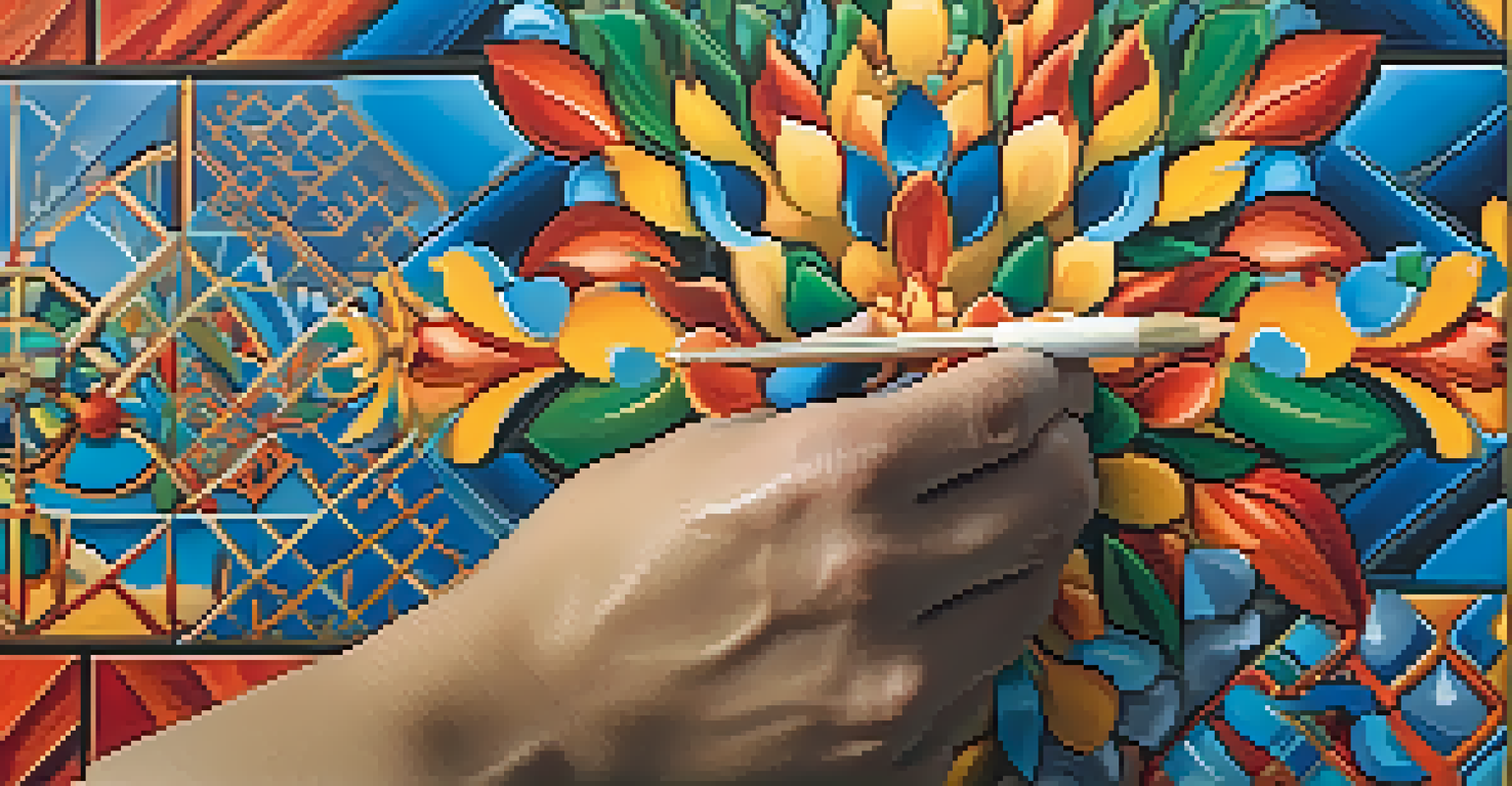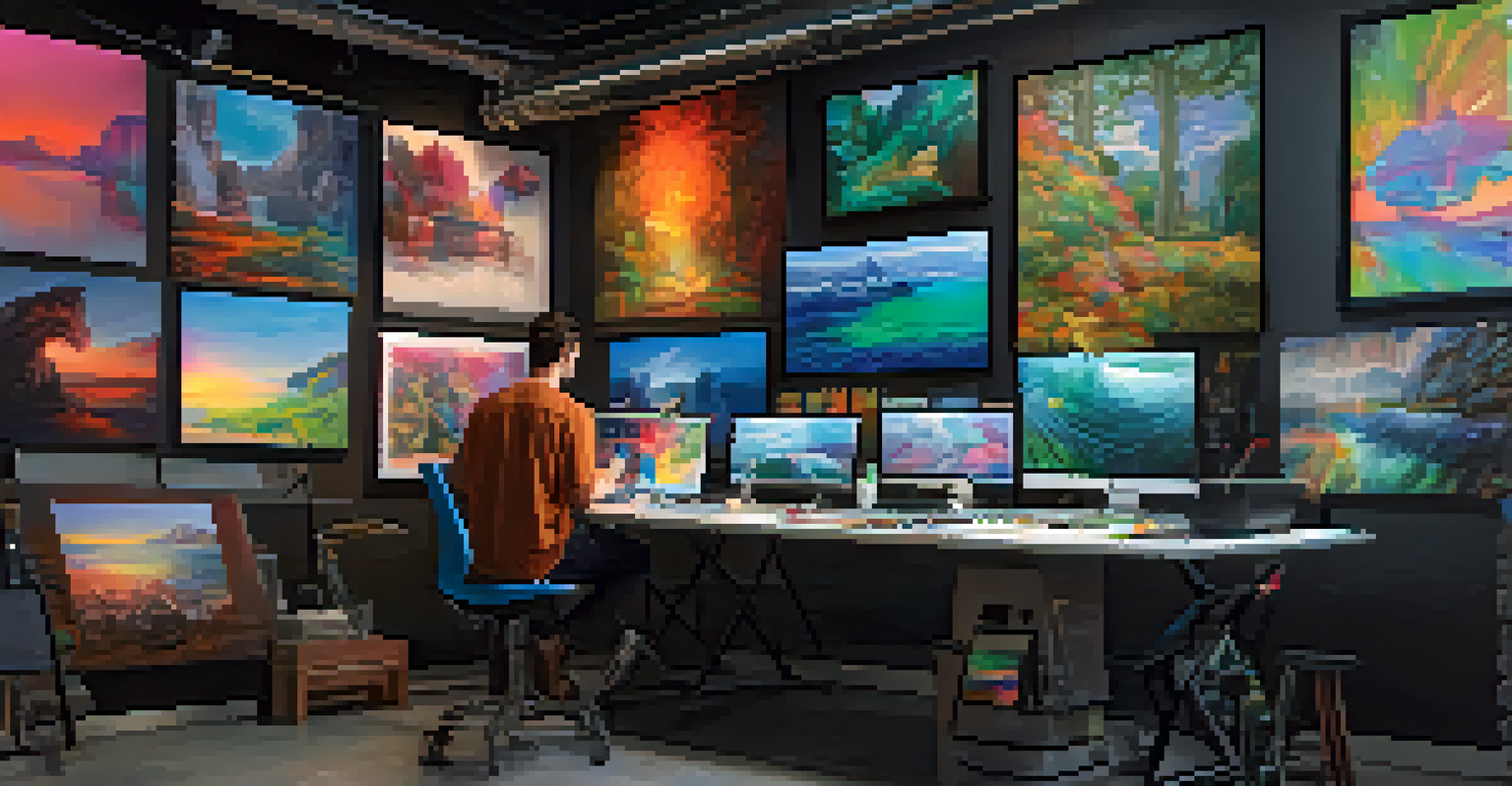The Intersections of Globalization and Art History Studies

Understanding Globalization and Its Impact on Art
Globalization refers to the interconnectedness of cultures and economies across the world. This phenomenon has significantly influenced art, allowing for a cross-pollination of ideas, styles, and techniques. As artists share their work globally, we see a blending of traditions that can lead to innovative forms of expression.
Art is a universal language that transcends boundaries and connects us all.
For example, contemporary artists often draw inspiration from various cultural influences, resulting in pieces that reflect a hybrid of styles. This not only enriches the art itself but also encourages viewers to engage with diverse perspectives. The art world becomes a vibrant tapestry, woven from threads of multiple cultures, showcasing the beauty of collaboration.
Moreover, globalization has facilitated the rise of digital platforms, enabling artists to reach audiences far beyond their local communities. This shift has democratized art, making it more accessible and diverse. As a result, the art scene is constantly evolving, reflecting the dynamic nature of our global society.
The Role of Art in Cultural Exchange
Art serves as a powerful medium for cultural exchange, allowing individuals to connect on a deeper level. When artists from different backgrounds collaborate or share their works, they create opportunities for dialogue and understanding. This exchange fosters empathy and appreciation for diverse cultures, highlighting our shared humanity.

Consider the impact of international art fairs, where artists from around the world showcase their creations. These events not only promote visibility for underrepresented voices but also encourage audiences to explore new ideas and narratives. Through art, we can break down barriers and challenge stereotypes, paving the way for a more inclusive world.
Globalization Enhances Artistic Diversity
Globalization fosters a blending of cultural influences in art, enriching expression and encouraging engagement with diverse perspectives.
Additionally, the integration of global themes in art history studies helps scholars examine how cultural contexts shape artistic practices. By analyzing these connections, we gain insights into the complexities of identity, power dynamics, and historical narratives. This understanding enriches our appreciation of art as a reflection of societal values.
Decolonizing Art History in a Global Context
Decolonizing art history involves challenging the Eurocentric narratives that have dominated the field for centuries. Globalization has provided a platform for marginalized voices, allowing for a reevaluation of traditional art historical frameworks. This process is essential for understanding the full spectrum of artistic expression across cultures.
In every work of art, in every cultural expression, there is a story waiting to be told.
By incorporating non-Western perspectives and practices, art historians can create a more inclusive narrative that honors diverse contributions. For instance, examining Indigenous art within its cultural context reveals rich histories and traditions often overlooked in mainstream discourse. This shift not only validates these art forms but also enriches our understanding of global art history.
Furthermore, decolonization encourages us to question who gets to tell art history and whose stories are being told. By fostering a more equitable approach, we empower underrepresented artists and promote a broader appreciation of global art heritage. This holistic perspective ultimately benefits both scholars and art enthusiasts alike.
Art as a Response to Global Issues
Contemporary art often reflects pressing global issues, such as climate change, migration, and social justice. Artists use their platforms to address these challenges, sparking conversations that resonate with audiences worldwide. This engagement not only raises awareness but also inspires action and solidarity among diverse communities.
For instance, many artists create works that comment on the refugee crisis, using their art to humanize the experiences of displaced individuals. By telling these stories, they challenge viewers to confront their own biases and assumptions. Art becomes a tool for advocacy, allowing marginalized voices to be heard in a global dialogue.
Art as a Medium for Cultural Exchange
Art facilitates cultural exchange, creating opportunities for dialogue and understanding among individuals from different backgrounds.
Moreover, the fusion of art and activism exemplifies the interconnectedness fostered by globalization. Artists collaborate with organizations and communities to create impactful projects that reflect shared concerns. This synergy not only amplifies the message but also reinforces the idea that art can drive social change.
The Influence of Technology on Global Art Practices
The advent of technology has revolutionized the way art is created, shared, and experienced. Digital tools and platforms enable artists to experiment with new mediums and reach audiences in innovative ways. This technological evolution has transformed traditional practices, allowing for greater experimentation and collaboration across borders.
For example, social media has become a vital tool for artists to showcase their work and connect with fans globally. Platforms like Instagram and TikTok allow emerging artists to gain visibility and build communities, often bypassing traditional gatekeepers. This shift democratizes the art world, giving voice to a diverse range of creators.
Additionally, technology plays a significant role in the preservation and accessibility of art. Virtual exhibitions and online galleries allow art enthusiasts to explore collections from anywhere in the world. This accessibility broadens the audience for art and encourages a more inclusive appreciation of global artistic heritage.
Challenges in Global Art History Studies
While globalization presents exciting opportunities for art history studies, it also poses several challenges. One significant issue is the risk of cultural appropriation, where artists may borrow elements from other cultures without proper understanding or respect. This can lead to misrepresentation and commodification of cultural symbols.
Moreover, as the art world becomes increasingly globalized, there is the danger of homogenization. Local traditions and unique artistic expressions might be overshadowed by dominant global trends, diluting the richness of diverse art forms. Maintaining the integrity of indigenous practices becomes crucial in this context.
Challenges of Global Art Practices
While globalization offers opportunities, it also presents challenges like cultural appropriation and the risk of homogenizing local art forms.
Lastly, navigating the complexities of global art markets can be daunting for emerging artists. The competition is fierce, and access to resources is often limited for those from underrepresented backgrounds. Addressing these inequalities is essential for fostering a truly inclusive global art community.
Future Directions in Global Art History Studies
As we look to the future, the intersection of globalization and art history studies will continue to evolve. Scholars and artists alike are increasingly embracing interdisciplinary approaches, drawing insights from sociology, anthropology, and cultural studies. This holistic perspective enriches our understanding of art in its global context.
Additionally, the rise of digital art forms and virtual exhibitions will shape the way we study and experience art. As technology continues to advance, new possibilities for engagement and collaboration will emerge, further transforming the art landscape. Keeping pace with these changes will be essential for art historians.

Moreover, fostering a dialogue between artists, scholars, and communities will be vital for creating a more inclusive art history. By prioritizing diverse voices and perspectives, we can build a richer understanding of art that reflects our interconnected world. The future of art history studies holds the promise of greater inclusivity and innovation.